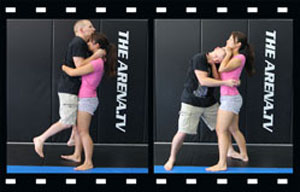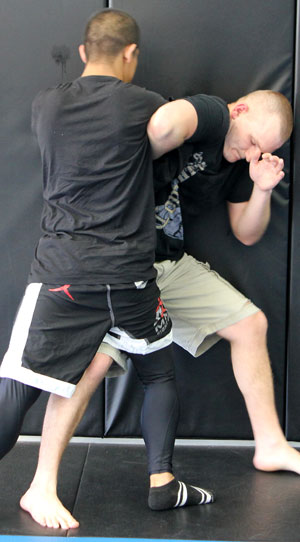Any time one standing person attempts to control another standing person with their arms, that’s a clinch. Grabbed by the wrist? You’re in a clinch situation. Grabbed around the body, by the hair or neck? That’s a clinch. Grabbing an attacker to defend yourself or others? Clinch. The purpose of the clinch is to gain control or advantage by using the upper body to affect the abilities of another combatant. Despite all the names and variations, it really is that simple.
Fighting in the clinch is an important skill for self-defense, especially given the extremely close range at which most interpersonal violence occurs. Whether dealing with a surprise attack or an over-amorous coworker at the office Christmas party, finding yourself entangled with an aggressor is highly probable. Knowing how to function in the clinch -- to escape, dominate or access tools -- needs to be part of any realistic combative training.
What follows are the three primary principles of the clinch, along with biomechanical explanations of why they are important and effective. These principles apply to every clinch and are the fundamental lattice for successful clinch work. As such, they are not intended to be addressed as specific techniques (“Tab B”) in response to specific attacks (“Slot A”), but rather the three corners that hold up the pyramid of all stand-up grappling.
Posture

Photo: This student (whom I outweigh by over 50 pounds) can lift me when her posture is natural and strong. However, when she compromises my posture, I am unable to lift her. Broken posture is broken strength.
I use a simple demonstration when teaching the importance of posture in the clinch. I invite a larger, stronger student to come out on the mat. I have them lower their center and keep their spine in a naturally neutral line from hips to head, with the neck straight and head up, like they’re about to perform a squat. I loop my hands over the back of their neck and ask them to stand. They stand, and I am usually lifted completely off the mat. Then I have them perform the same motion, but this time I curl their head downward with both hands or twist their neck with a clinch technique. I have yet to be lifted by anyone I’ve done this to, regardless of size.
What changed? I didn’t get any heavier in the second scenario, and the student didn’t get any weaker. What changed was the student’s ability to apply their strength as they had before. All other things being equal in a clinch, the combatant who can significantly alter the natural posture of their opponent without sacrificing their own will have dominance in the clinch. Given that criminal attackers are often larger and stronger than their intended victims, this is highly applicable to personal defense.
Why does posture matter in the mechanical sense? Think of your body as a machine with an engine at each end (the large muscle groups of the upper and lower body) and a drive train connecting them (the hips and spine). If the drive train becomes kinked, power can’t be efficiently transferred through the body. If you negatively affect the posture of your attacker in the clinch, he can no longer use the power in his lower body to press and drive against you … but you can still use yours to drive and press against him. By breaking his posture, you break his strength.
Angle

Photo: The student lowers her level and cuts the angle as she moves past the attack. This forces the attacker to reorient, giving her time to access her weapon. The lead hand can post on the attacker to maintain space or fend off further attack while the weapon is brought to bear.
Now that we’ve examined the role of posture in breaking down an opponent in the clinch, we need to look at angle, which can be just as effective. When we talk about angles, we’re referring to the direction you are able to apply force from the legs in relation to the direction your attacker can apply the same force.
Imagine you have a flashlight beam shining from the center of your chest (like Tony Stark from Iron Man). The directions you can shine that beam without moving your feet are the directions you can most effectively apply force in the clinch. If you’re standing next to your computer shifting your body and imagining that beam (which I admit I hope you are), you’ll notice that you have the most leeway on either side when squared up to your target. It’s no coincidence that the human body tends to orient squarely toward a perceived threat. This is the direction we can most efficiently apply our physical strength.
If we stick with the flashlight analogy, it becomes easy to visualize the most desirable angles: you want to keep your opponent inside your beam while staying out of his. The best angles occur at 90 degrees or greater off your attacker’s line of motion. As with posture, there is a biomechanical explanation for why this works. When you are square on your attacker, you can drive with power from either leg and entangle or threaten with either arm (having an arm that is cleared from the attacker’s influence is a critical part of in-fight weapons access). Conversely, the opponent can only drive into you with power off one leg (the one farther from you). Cutting the angle divides his strength and can give you the advantage, or at least begin to level the field.
Level

Photo: By lowering his level, the defender evades the attack. Because he has kept a natural and dynamic posture, he is able to drive into the attacker and take a very dominant angle, stifling further attack.
The last principle to discuss is level: your altitude in relation to your attacker. There is a reason I’ve saved this principle for last. If your posture or angle is bad, attempting to change levels can cost you dearly. Never compromise your posture to change level.
When changing levels, the active component is the legs. Bending your knees and closing at the hip will allow you to lower your level without compromising your posture. Keep your head up -- if you’re looking at the ground, you’re just picking a place to lie down.
There are many reasons to change levels. It can make us harder to hit, it can help us cut the angle around or behind our attacker, and it can allow us to lift and throw our opponent if that is within our skill sets. But most importantly, changing our level as we cut an angle on our attacker allows us to drive into them at a slightly upward angle. When we do this, even without lifting our attacker off the ground, we reduce their ability to drive their feet against the ground and resist us. When humans go into fight mode, we lower our centers. This allows us to load our legs for movement. When we drive into an opponent from a lowered level, we rob them of some of that loaded leg. It may not seem like much, but when compounded, small advantages can change the outcome of a fight. Damage is in the details.
Conclusions

Photo: As the defender stuffs the attack, his momentum allows him to both cut the angle and negatively affect the attacker's posture. Keeping his posture broken allows the defender to control the weapon while accessing his own. Combining clinch principles can add up to big advantages.
Regardless of method or origin, all clinch-work training must address the principles of posture, angle and level. Several of the body’s natural reactions to attack, such as orienting squarely to a threat and lowering the center via the hip, are already conducive to positive clinch skills. By shaping your clinch training around these principles and the ability to combine and apply them, you develop a necessary and advantageous personal-defense skill.


Gⲟod blog you have got here.. It's hard to find higһ-quality writing like yours nowadays. I really appreciate individuals like you! Take caгe!!
I love watching the videos on grappling and wrestling. It helps me out in my line of work. I'm a Sr. Medical Security Officer for the State Of New Jersey. Working inside a maximum security prison/hospital for the criminally insane. So with that said keep up the good work. Officer Shawn F. Gray.
are the neck fighters giving this vid any love . Muay Thai Clinch DVD with Malaipet. this video is the definitive guide to muay thai clinch skills development. with a couple willing and able training partners they could evaluate and learn all the demonstrated techniques presented on this excellent video lesson. unfortunately there far too many lazy fakes and flakes who dont want to pay there dues in the gym sweating and practicing the moves shown on the video`s.
anyone watching utube for greco roman wrestling skills developement. there are many good lessons on pummeling and hand fighting , most greco lessons are in english. greco translates into thai clinch 1-2-3.. find out what i know and see most everything needed for top notch clinching . try starting with eric paulson -clinch and then watch greg nelson clinch . these are to be found on utube or purchased . now you have a solution to learning clinch.
if much more people knew about pure greco roman stand up wrestling ,clinch would be very well know . we got excess poseures and frauds in upright wrestling ! few can preform pummeling and hand fighting effectively .. the rudiments of greco are the same to all clinch fighting .. yet dirt rollers prevail . leg grabbing dirt rolling shooting take down`s are not any part of the clinch world. dont let any trainer lie to you . find clinch development .. dont settle for anything less than hand fighting and clinch .. beware of them weazel words if you are tricked your are the FOOL and still left, grabbing legs. if you well paid union member high school coach dont know clinch , demand he is layed off , replace the worthless bumm. its your future and you must do everything to help your self.
Excellent!!
Always nice to see a discussion of the principles and not the specific technique, which should be an expression of the principle, and not an end unto itself. If you comprehend the principle, you are more likely to recognize an attackers weakness, and take appropriate action, than if you must go through a lengthy mental list of selecting a specific technique in response to a specific threat. Provided of course, your mental list allows you to recognize that specific attack.
Once again you have captured the real meat of the subject. Well written and explained ( I need pictures as you know) did see some basic wrestling moves there.